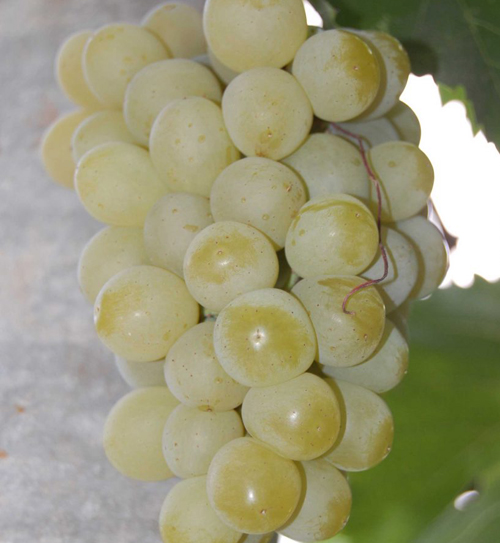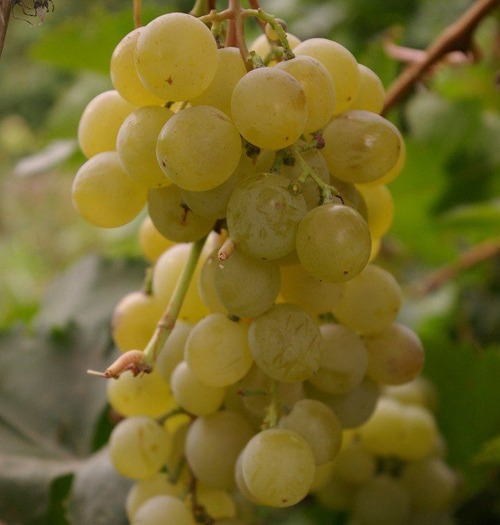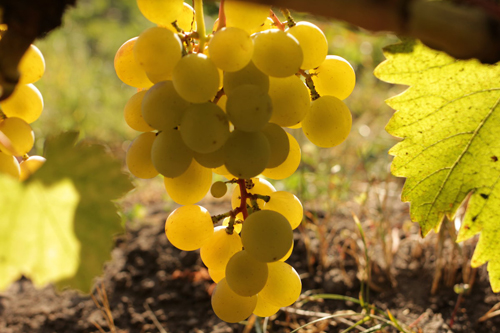Galbena nou (Zolotinka) grape variety
Galbena nou is a universal, complex-stable hybrid of grapes, bred by scientists from the All-Russian Research Institute of Viticulture and Winemaking named after V.I. ME AND. Potapenko. Obtained from crossing the Moldavian variety Frumoasa alba with the domestic seedless grape Korinka Russian. The direct authors of the form were I.A. Kostrikin, L.A. Maistrenko, A.N. Maistrenko, S.I. Krasokhina. The variety has the synonymous name Zolotinka, and it was under this name that it was patented in 2013, and is currently undergoing a variety trial for the right to be included in the State Register of Breeding Achievements of the Russian Federation and gain access to industrial cultivation.

Distinctive features of Zolotinka, in addition to unpretentious cultivation, are early ripeness, great taste and aroma of its fruits, which have a truly bewitching effect due to strong nutmeg shades. Unfortunately, as a table variety, our heroine loses to many modern hybrid forms in terms of marketability of the appearance of bunches, but her advantage is the ability to become an excellent raw material for the manufacture of various types of wines, to which she fully conveys her nutmeg aroma. The productivity of the form is potentially high, but its achievement will require the implementation of competent rationing of fruiting bushes.
Since its inception, the hybrid has already become very widespread among amateur winegrowers, who managed to conduct their own variety testing. Some of them rejected Galbena know for reasons of insufficient, in their opinion, aesthetic appeal, while others became her sincere admirers for the uniqueness of gastronomic properties and versatility in use.

Agrobiological properties
Plants show unrestrained growth force, especially in the case of insufficient crop load. The crown of the young shoot is closed, with tomentose pubescence. Young leaves are shiny greenish-bronze color. A full-fledged leaf is large, rounded or stretched in width, five-lobed with an average or strong degree of dissection. The surface of the leaf blade is smooth, rich green, the veins at the base often acquire a reddish tint. The upper lateral incisions on strongly dissected leaves are deep, closed with an ovoid lumen or open in the form of a lyre with a rounded bottom. The lower notches are smaller but similar in shape. In moderately dissected ones, all notches are open, of moderate depth, slit-like, or in the form of a reentrant angle. The petiolate notch is vaulted in all cases, differing only in width. Petioles not too long, green with pink longitudinal stripes. The leaf profile is flat or slightly wavy. The teeth along the perimeter are relatively large, in the form of elongated triangles with slightly convex lateral edges and sharp tops. Flowers are bisexual, well fertilized with their own pollen. Plants are not prone to peeling berries, however, some owners complain of periodic shedding of inflorescences, which is why the brushes turn out to be rather loose. This flaw, however, is not characteristic of the variety and appears only in specific climatic conditions. The shoots of the current year have time to mature perfectly, almost to the entire length. After ripening, the vine acquires a yellowish brown color in the internodes and a darker shade in the area where the nodes are located.

Bunches of Galbena nou grapes grow above average in size, reaching a weight of 400 - 500 grams.The largest fruits are formed on mature bushes with a large supply of perennial wood. In this case, you can often get brushes weighing up to 600 grams. Their shape is broadly conical, the density is usually average. The grapes are not in close contact with each other, which prevents them from crushing and deformation. The combs are long, herbaceous, greenish, but often with noticeable anthocyanin pigmentation. The berries are large, round, with a diameter of 23 - 24 mm and an average weight of 6 - 8 grams. The outer color, depending on the degree of maturity and illumination of the fruit zone, can vary from greenish-yellow to amber, the surface is covered with a whitish coating of a protective spring of medium intensity. The pulp of the grapes is moderately dense, juicy-fleshy consistency, with a perfectly balanced taste and a bright aroma of nutmeg. The sugar content of berry juice can reach 23 g / 100 ml, while the titratable acidity is kept at the level of 6 - 8 g / l. The skin is medium in thickness, firm, but chewable when eaten. Seeds are present, usually 2 - 3 in number in grapes, however, they do not carry much discomfort in gastronomic terms. Tasting assessment of fresh grapes is about 7.9 - 8.0 points.
The harvest of Galbena know is used for consumption directly in food, for the manufacture of alcoholic and non-alcoholic beverages, as well as for various home preservation. The "marketability" of the form is not too high, and therefore the farmers who cultivate the "sunny berry" for fresh sale do not particularly favor our heroine, preferring more spectacular varieties to her. But many amateurs who cultivate grapes for their own consumption respect Zolotinka precisely for its versatility. Juices, compotes, and even dry and dessert wines are produced from it of consistently high quality. In particular, the organoleptic qualities of dry table wine material are assessed by experts at least 7.7 points.
Productivity can reach high values due to a significant number of fruitful shoots (70 - 85%) and a good fruiting rate (1.1 - 1.4). Bushes are even prone to crop overload and require limiting the load during spring pruning with 30 - 35 eyes with a strong or moderate shortening of fruit arrows to 3 - 4 and 6 - 8 buds, respectively. Plants should not be overly unloaded either. in this case, they begin to "fatten", aimlessly increasing the vegetative mass.
The variety is one of the early ripening varieties with a vegetation period of 113 - 115 days and a sum of active temperatures of 2300 - 2400 ° C necessary for the ripening of the bunches. This allows it to grow not only in the south, but also in a number of areas of the middle zone of the country. The frost resistance of the vine is about -25 ° C. Resistance to mildew at 2.5 points, mildew and gray mold - 3.5 points. Wasps of Galben know are moderately damaged. With a long stay on the bushes after ripening, the berries can crack in case of heavy rains or a sharp change in soil moisture due to abundant watering.








